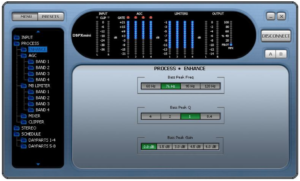The BW Broadcast DSPXmini-AM Audio Processor

[January 2011] Audio processing is a very personal art – often what sounds good to one person will make another cringe. But at its base, broadcast processing is about producing a tight but clean audio package, inviting to the listener. Dana Puopolo not only found a processor that does the job, but one that is easy on the budget.
How would you react to someone telling you they took a station with thin, distorted audio and turned it into one with a killer sound for under $1500? If you had asked me, I would not have believed it.
But, after doing just that myself, now I am a believer.
A Station in Need
When I took over as Chief Engineer at WURD the station audio, though very loud, sounded thin and quite distorted.
WURD radio in Philadelphia is locally owned and operated, and features a variety format, based on talk but also running block and music programs. The RF plant was in perfect shape driving the two-tower DA with a BE AM1 solid-state transmitter through a broad-banded phasor and a flatnet network.
Initially I suspected the Orban 9100B audio processor as the problem, some major problems with the 15 kHz analog audio line did not help. Once we dealt with the program lines the sound became quite a bit better, but just not “right.”
Something was clearly missing.
An Intriguing Suggestion
After speaking with a friend I met at NAB (Scott Incz, one of the owners of BW Broadcast), he suggested I try his new AM audio processor, the DSPX mini AM. I told him that I had only a limited amount of money and a lot of projects pending, but when he told me it listed for only $1500.00, my curiosity was aroused. How good can a processor this cheap sound?

A Very Quick Install
When the demonstration unit arrived, I immediately put it on line. The setup was quick and easy. This unit uses a large knob that you use to select your parameter, then you push the knob to navigate down to the next menu.
I put it in the rack, set the preset „aggressive talk‟, set the asymmetry to 125% and slowly turned up the output-where I found the asymmetry was backwards in that the negative peaks were larger than the positive ones. No problem – the unit has the ability to correct this from the front panel.
Once the DSPXmini-AM was operating (which took a total of about 10 minutes from opening the box to getting it in the rack and ready to listen), I went out to the car and checked it out. I could not believe what I was hearing; the station truly had been transformed. The audio was loud – very loud – but was not distorted at all. There was no apparent pumping of any other artifacts, just very loud and incredibly clean signal. That includes the low end. There was a lot of very clean bass.
In operation, it turns out that this processor calls very little attention to itself – it simply gives you more of what you already have. The only pre-processing we use is an Aphex Compellor at the studio, mainly set for AGC to protect the STL path.
Running Well
After a couple of day I decided to tweak the audio just a bit. I turned the bass filter down a bit and lowered the output filter to 8.5 kHz from 10 kHz. That is all I had to do with this processor to get just the sound I wanted.
My little 1 kW station now is about 4 dB louder than the class A, 50 kW stations here in Philly. No one can touch it either in loudness or quality. The DSPXmini-AM also increased the station‟s range by over 20 miles. Every staff member can hear the improvement over the Orban, as can many local engineers (who have called me to compliment me on the sound of WURD).
Looking at the Engine
Now to some specifics: The basic processor is comprised of a 4-band AGC followed by a 4-band peak limiter followed by an output filter.
Four bands is ideal for AM where most energy is under 5 kHz. Most every parameter of both AGC and limiter are adjustable as are their mix outputs, various filters and equalizers, etc. The presets are a good start – none of them will make your station sound bad. There are also 8 memories to store your own presets, and a real time clock to allow you to daypart your processing. (You can also select presets via closures on the back of the unit.)
The DSPXmini-AM also features peak clipper that has a “finesse” control that allows for the dynamic control of clip depth – something I have never seen before on such a value processor. It also allows the asymmetry that is present on voices to be used for maximum benefit on an AM transmitter that can do positive modulation of 125% (or more).
Finally there is a steep slope overshoot compensated low-pass filter that is use for NRSC. All of these filters are done in DSP.
Fine Tuning
The four-line alphanumeric DSPXmini-AM display tells you all that you need to know about what is going on under the hood. It can also be connected to the Internet and controlled remotely with a computer. The software comes with the processor.

By the way, as you can see, the DSPXmini-AM is a stereo unit, although for this particular installation station I only needed one channel. All the connections are via XLR connectors or the RJ45 plug.
This is truly a breakthrough product. There is nothing under $2500.00 that can touch it. The DSPXminiAM would be an amazing product priced at $3500.00. It is 100% digital, stable as a rock and sounds great. For $1500.00 it is simply a major steal. What have you got to lose, except your bad on air audio?
– – –
Dana Puopolo is the Chief Engineer at WURD and a long-time audio processing enthusiast. Dana’s email is dpuopolo@usa.net
